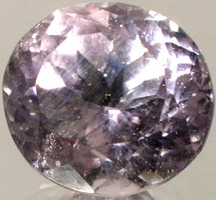













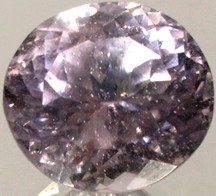
Antique Genuine Natural Afghani Seven and One-Half Carat Faceted White (Pastel Pink) Kunzite Oval Cut Semi-Precious Gemstone.
CLASSIFICATION: Faceted White/Pink Kunzite Oval.
ORIGIN: Afghanistan. 19th Century.
SIZE: Length: 11 1/2mm. Width: 10 1/2mm. Depth: 8 1/2mm. All measurements approximate.
WEIGHT: 7.46 carats.
NOTES: Upon request we can set your gemstones as a ring, pendant, or as earrings (click here for more information).

DETAIL: In the ancient world kunzite was traditionally worn as a talisman which was believed to bring good luck to the wearer. Its soft pastel colors also came to symbolize purity. Well known to Indian and Russian jewelers of the eighteenth and nineteenth century, but “newly discovered” in America in the twentieth century, violet to pink shades of kunzite have become enormously popular in the first decade of the twenty-first century. Originally referred to as “pink amethyst” in Central Asia and Eastern Europe, it is a rare and gorgeous gemstone which typically can shift colors between pink-violet, and (depending on how it is cut) on occasion, green. It is noted for its feminine and alluring hues which range between pastel pinks and violets to intense, almost “neon” hues. Depending on the cut, it can also possess incredible sparkle and brilliance.
HISTORY OF KUNZITE: Kunzite is an unusual and rare gemstone. It is the pink or violet-colored variety of the spodumene family, cousin to hiddenite (green spodumene) and triphane (yellow or colorless spodumene). It was known in Central Asia and in Eastern Europe as early as the sixteenth century from sources in Afghanistan and Russia. It was believed by Russian jewelers to be a variety of pink amethyst. There are also references to it in ancient Hindu texts, where it was referenced as having been produced in what is present-day Pakistan. Kunzite was first “discovered” (officially at least, as reported in Western sources) in America at the Pala Chief Mine near San Diego, California. The “newly discovered” gemstone was named after Tiffany’s chief gemologist George Frederick Kunz, who was the first to give a comprehensive (and published) description of the gemstone shortly after the turn of the twentieth century. Another spodumene variety “discovered” in America few decades prior to kunzite was named “hiddenite”, after A. E. Hidden, who was one of the original mine owners wherein this spodumene variety was found (in North Carolina).
By whatever name, kunzite, hiddenite, and triphane are all still best known to geologists as “spodumene” (first described in literature in 1800 A.D.). The name spodumene is derived from the Greek spodumenos, which meant “burnt to ashes”, in reference to spodumene's commonly occurring light gray color. Spodumene is a major source of lithium, trace amounts of which is what gives it its pink color; violet undertones are created by traces of manganese. Lithium has a great variety of uses including in the manufacture of lubricants, ceramics, batteries, welding supplies, experimental fuels and in anti-depressant drugs. Kunzite displays two unusual characteristics; “phosphorescence” whereby kunzite, in this respect similar to diamond, is observed to glow in a darkened room after it has been exposed to the sun’s ultra-violet rays; and “pleochroism”, showing two different colors when viewed from different directions. Kunzite is actually trichroic, meaning it can appear up to three different colors, depending on the angle from which it is viewed. It can appear very strongly violet from one angle, light purple/violet/pink from another, and pale green or colorless from a third angle of view.
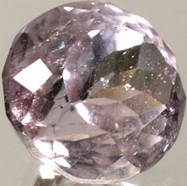
Kunzite commonly shows violet, pink, yellow or green hues depending upon the orientation of the cut gemstone. Transparent spodumenes of pink to violet color (kunzite) and yellowish-green to medium deep green (hiddenite) are used as gemstones. Kunzite is particularly noteworthy for its feminine and alluring hues which range between pastel pinks and violets to intense, almost “neon” hues. Depending on the cut, it can also possess incredible sparkle and brilliance. Kunzite is presently mined in the United States, Canada, Mexico, Brazil, Afghanistan, Pakistan, Burma, Ceylon, Finland, Sweden, Russia, Australia, Mozambique, Nigeria and Madagascar. It is often found in association with other two semi-precious pink gemstones; morganite and pink tourmaline. The largest known faceted kunzite gemstones include a 614 carat pear at the University of Delaware's mineral museum, and an 880 carat gemstone on display in the Smithsonian Institution's collection in Washington D.C.
Kunzite was virtually unknown to the American public until the Sotheby's auction of a very special kunzite ring in 1996. Among the jewelry from the Estate of Jacqueline Kennedy Onassis was a ring with a 47 carat cushion cut kunzite stone surrounded by 20 round diamonds set in 18k gold. The ring was originally purchased by President John F. Kennedy as a Christmas gift for his wife in 1963. The ring was never “presented” by the President to his wife, as he was assassinated the month prior to Christmas (in November 1963). Throughout the history of the ancient world, gemstones were believed capable of curing illness, possessed of valuable metaphysical properties, and to provide protection. Found in Egypt dated 1500 B. C., the "Papyrus Ebers" offered one of most complete therapeutic manuscripts containing prescriptions using gemstones and minerals. Gemstones were not only valued for their medicinal and protective properties, but also for educational and spiritual enhancement.
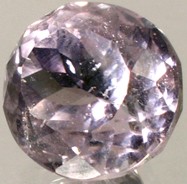
In the ancient world kunzite was traditionally worn as a talisman which was believed to bring good luck to the wearer. Its soft pastel colors also came to symbolize purity. New age shamans and metaphysical practitioners regard it as a symbol of new life, specifically pregnancy, and believe that it also opens the path to spirituality for new wearers, revealing the inner soul and the “purpose” of their incarnation. It is also believed to help the wearer understand and interact better with others, to help heal "broken hearts" (and is considered especially beneficial for those who have experienced a failed relationship or marriage), to relieve stress and anger, dissolve negativity, and to bring love, peace and harmony. It is also said to be useful for increasing the wearer’s inner strength and sense of self worth, for removing emotional blockages originating in past (i.e., childhood) experiences. It is also said to stimulate sensitivity and sensuality. It is sometimes referred to as a “stone of balance”, offering its wearer emotional calmness, security, and maturity. Kunzite is believed to help strengthen the circulatory system, and to be helpful in the treatment of lung disorders, psychiatric disorders, chemical dependencies and addictions, and depression.
SHIPPING & RETURNS/REFUNDS: Your purchase will ordinarily be shipped within 48 hours of payment. We package as well as anyone in the business, with lots of protective padding and containers. All of our shipments are fully insured against loss, and our shipping rates include the cost of this coverage (through stamps.com, Shipsaver.com, the USPS, UPS, or Fed-Ex). International tracking is provided free by the USPS for certain countries, other countries are at additional cost. ADDITIONAL PURCHASES do receive a VERY LARGE discount, typically about $5 per item so as to reward you for the economies of combined shipping/insurance costs. We do offer U.S. Postal Service Priority Mail, Registered Mail, and Express Mail for both international and domestic shipments, as well United Parcel Service (UPS) and Federal Express (Fed-Ex). Please ask for a rate quotation. We will accept whatever payment method you are most comfortable with.
 Please note for international purchasers we will do everything we can to minimize your liability for VAT and/or duties. But we cannot assume any responsibility or liability for whatever taxes or duties may be levied on your purchase by the country of your residence. If you don’t like the tax and duty schemes your government imposes, please complain to them. We have no ability to influence or moderate your country’s tax/duty schemes. If upon receipt of the item you are disappointed for any reason whatever, I offer a no questions asked 30-day return policy. Send it back, I will give you a complete refund of the purchase price; 1) less our original shipping/insurance costs, 2) less any non-refundable eBay fees. Please note that though they generally do, eBay may not always refund payment processing fees on returns beyond a 30-day purchase window. So except for shipping costs and any payment processing fees not refunded by eBay, we will refund all proceeds from the sale of a return item. Obviously we have no ability to influence, modify or waive eBay policies.
Please note for international purchasers we will do everything we can to minimize your liability for VAT and/or duties. But we cannot assume any responsibility or liability for whatever taxes or duties may be levied on your purchase by the country of your residence. If you don’t like the tax and duty schemes your government imposes, please complain to them. We have no ability to influence or moderate your country’s tax/duty schemes. If upon receipt of the item you are disappointed for any reason whatever, I offer a no questions asked 30-day return policy. Send it back, I will give you a complete refund of the purchase price; 1) less our original shipping/insurance costs, 2) less any non-refundable eBay fees. Please note that though they generally do, eBay may not always refund payment processing fees on returns beyond a 30-day purchase window. So except for shipping costs and any payment processing fees not refunded by eBay, we will refund all proceeds from the sale of a return item. Obviously we have no ability to influence, modify or waive eBay policies.
ABOUT US: Prior to our retirement we used to travel to Eastern Europe and Central Asia several times a year seeking antique gemstones and jewelry from the globe’s most prolific gemstone producing and cutting centers. Most of the items we offer came from acquisitions we made in Eastern Europe, India, and from the Levant (Eastern Mediterranean/Near East) during these years from various institutions and dealers. Much of what we generate on Etsy, Amazon and Ebay goes to support worthy institutions in Europe and Asia connected with Anthropology and Archaeology. Though we have a collection of ancient coins numbering in the tens of thousands, our primary interests are ancient/antique jewelry and gemstones, a reflection of our academic backgrounds.
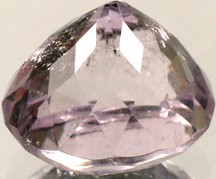 Though perhaps difficult to find in the USA, in Eastern Europe and Central Asia antique gemstones are commonly dismounted from old, broken settings – the gold reused – the gemstones recut and reset. Before these gorgeous antique gemstones are recut, we try to acquire the best of them in their original, antique, hand-finished state – most of them originally crafted a century or more ago. We believe that the work created by these long-gone master artisans is worth protecting and preserving rather than destroying this heritage of antique gemstones by recutting the original work out of existence. That by preserving their work, in a sense, we are preserving their lives and the legacy they left for modern times. Far better to appreciate their craft than to destroy it with modern cutting.
Though perhaps difficult to find in the USA, in Eastern Europe and Central Asia antique gemstones are commonly dismounted from old, broken settings – the gold reused – the gemstones recut and reset. Before these gorgeous antique gemstones are recut, we try to acquire the best of them in their original, antique, hand-finished state – most of them originally crafted a century or more ago. We believe that the work created by these long-gone master artisans is worth protecting and preserving rather than destroying this heritage of antique gemstones by recutting the original work out of existence. That by preserving their work, in a sense, we are preserving their lives and the legacy they left for modern times. Far better to appreciate their craft than to destroy it with modern cutting.
Not everyone agrees – fully 95% or more of the antique gemstones which come into these marketplaces are recut, and the heritage of the past lost. But if you agree with us that the past is worth protecting, and that past lives and the produce of those lives still matters today, consider buying an antique, hand cut, natural gemstone rather than one of the mass-produced machine cut (often synthetic or “lab produced”) gemstones which dominate the market today. We can set most any antique gemstone you purchase from us in your choice of styles and metals ranging from rings to pendants to earrings and bracelets; in sterling silver, 14kt solid gold, and 14kt gold fill. When you purchase from us, you can count on quick shipping and careful, secure packaging. We would be happy to provide you with a certificate/guarantee of authenticity for any item you purchase from us. There is a $3 fee for mailing under separate cover. I will always respond to every inquiry whether via email or eBay message, so please feel free to write.


